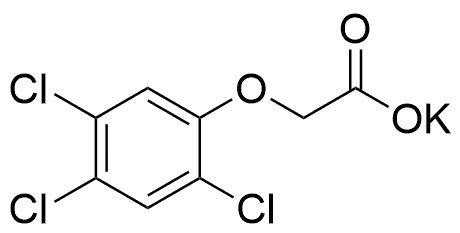Potassium 2,4,5-Trichlorophenoxyacetate is widely utilized in research focused on:
- Agricultural Herbicide: This compound is primarily used as a herbicide to control broadleaf weeds in various crops, enhancing agricultural productivity and reducing competition for resources.
- Environmental Research: It serves as a model compound in studies investigating the environmental fate and transport of chlorinated compounds, helping researchers understand their impact on ecosystems.
- Toxicology Studies: The chemical is employed in toxicological research to assess the effects of chlorinated phenoxy compounds on human health and wildlife, contributing to safety evaluations.
- Analytical Chemistry: It is used as a standard in analytical methods for detecting and quantifying chlorinated phenoxy acids in environmental samples, ensuring accurate monitoring of pollutants.
- Phytotoxicity Testing: This compound is applied in laboratory settings to evaluate the phytotoxic effects on various plant species, aiding in the development of safer herbicides.
General Information
Properties
Safety and Regulations
Applications
Potassium 2,4,5-Trichlorophenoxyacetate is widely utilized in research focused on:
- Agricultural Herbicide: This compound is primarily used as a herbicide to control broadleaf weeds in various crops, enhancing agricultural productivity and reducing competition for resources.
- Environmental Research: It serves as a model compound in studies investigating the environmental fate and transport of chlorinated compounds, helping researchers understand their impact on ecosystems.
- Toxicology Studies: The chemical is employed in toxicological research to assess the effects of chlorinated phenoxy compounds on human health and wildlife, contributing to safety evaluations.
- Analytical Chemistry: It is used as a standard in analytical methods for detecting and quantifying chlorinated phenoxy acids in environmental samples, ensuring accurate monitoring of pollutants.
- Phytotoxicity Testing: This compound is applied in laboratory settings to evaluate the phytotoxic effects on various plant species, aiding in the development of safer herbicides.
Documents
Safety Data Sheets (SDS)
The SDS provides comprehensive safety information on handling, storage, and disposal of the product.
Product Specification (PS)
The PS provides a comprehensive breakdown of the product’s properties, including chemical composition, physical state, purity, and storage requirements. It also details acceptable quality ranges and the product's intended applications.
Certificates of Analysis (COA)
Search for Certificates of Analysis (COA) by entering the products Lot Number. Lot and Batch Numbers can be found on a product’s label following the words ‘Lot’ or ‘Batch’.
*Catalog Number
*Lot Number
Certificates Of Origin (COO)
This COO confirms the country where the product was manufactured, and also details the materials and components used in it and whether it is derived from natural, synthetic, or other specific sources. This certificate may be required for customs, trade, and regulatory compliance.
*Catalog Number
*Lot Number
Safety Data Sheets (SDS)
The SDS provides comprehensive safety information on handling, storage, and disposal of the product.
DownloadProduct Specification (PS)
The PS provides a comprehensive breakdown of the product’s properties, including chemical composition, physical state, purity, and storage requirements. It also details acceptable quality ranges and the product's intended applications.
DownloadCertificates of Analysis (COA)
Search for Certificates of Analysis (COA) by entering the products Lot Number. Lot and Batch Numbers can be found on a product’s label following the words ‘Lot’ or ‘Batch’.
*Catalog Number
*Lot Number
Certificates Of Origin (COO)
This COO confirms the country where the product was manufactured, and also details the materials and components used in it and whether it is derived from natural, synthetic, or other specific sources. This certificate may be required for customs, trade, and regulatory compliance.


